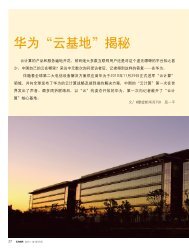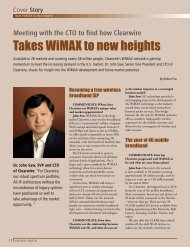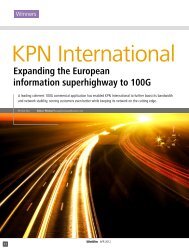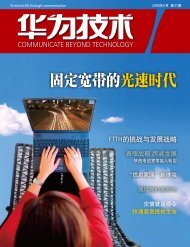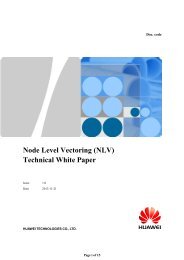Telekom Malaysia - Huawei
Telekom Malaysia - Huawei
Telekom Malaysia - Huawei
Create successful ePaper yourself
Turn your PDF publications into a flip-book with our unique Google optimized e-Paper software.
Perspectives<br />
With GID capabilities, the IoV need no longer rely solely on static,<br />
external information sources. Sources can now be more diverse and far-reaching,<br />
but this will require major changes to ITS technologies.<br />
Micro system<br />
Macro system<br />
Unidirectional<br />
Lack of<br />
intelligence<br />
Non-ID<br />
Three functions of GID<br />
Short range<br />
Small coverage<br />
0.001%<br />
Passive<br />
1. Ubiquitous and converged communication<br />
2. Online vehicle IDs (digital gene IDs)<br />
Slow movement<br />
High TCO,<br />
invisible<br />
Non-standard<br />
3. Intelligent perception (enabling real-time<br />
vehicle status, ITS, SON, and IoV)<br />
Fig. 1 GID vs. RFID<br />
Vehicle and traffic status information can be gathered from the<br />
CAN bus and other sources; such information covers driving<br />
(location, direction, speed, and acceleration), status (inside and<br />
outside temperature, air flow, and tire pressure), power (fuel<br />
pressure, rotational speed, and oil level), vehicle safety (seatbelt,<br />
airbag, and door/window lock status), and environment (weather,<br />
road conditions, and congestion levels).<br />
GID-based IoV system<br />
Mutual IoV & ITS development<br />
IoV development has everything to do with ITS,<br />
automotive electronics, and mobile Internet access. Nextgen<br />
ITS development requires the overcoming of challenges<br />
such as comprehensive traffic status information access,<br />
timely detection of road conditions and vehicle operating<br />
status, and intelligent release of information based on relevant<br />
factors such as vehicle/road conditions, thereby providing<br />
travelers with more effective traffic information; this makes<br />
transportation more eco-friendly and efficient.<br />
ITS depends on the road and the vehicle equally.<br />
Traditional ITS solutions involve static and fixed road-related<br />
elements such as roadside units (RSUs), video shooting, roadside<br />
displays, RFID readers, traffic condition displays, and<br />
pressure-sensitive coils, but overlook the fact that vehicles<br />
themselves are the most relevant factors that affect traffic<br />
conditions, accidents and the roadside environment.<br />
The advent of GID-based IoV represents the evolution and<br />
advancement of traditional M2M and telematics. With GID<br />
capabilities, the IoV need no longer rely solely on static, external<br />
information sources. Sources can now be more diverse and farreaching,<br />
but this will require major changes to ITS technologies.<br />
Relationships between IoV and cloud<br />
computing<br />
The IoV will eventually generate much more information<br />
than the telecom industry. Take the ITS for example; the<br />
25<br />
DEC 2011



